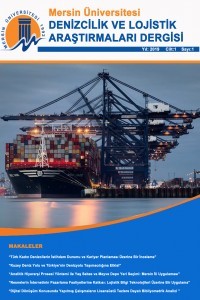KUZEY DENİZ YOLU VE TÜRKİYE’NİN DENİZYOLU TAŞIMACILIĞINA ETKİSİ
İklim değişikliği ve küresel ısınmayla birlikte kutup bölgelerindeki buzulların erimesi küresel problemler ve fırsatlar ortaya çıkarmaktadır. Bu fırsatlardan biri de Kuzey Buz Denizi’ndeki buzulların erimesiyle birlikte daha aktif kullanılması düşünülen Kuzey Deniz Yolu’dur. Günümüzde oldukça ilgi odağı olan bu yeni rotanın Asya-Avrupa arası mevcut ticari rotadan daha ekonomik ve verimli olacağı, böylelikle dünya ticaret rotasında değişim yaratacağı düşünülmektedir. Bu çalışmada Kuzey Deniz Yolu’nun güncel durumu incelenmiş ve bu rotanın Asya ile Avrupa arasında bir bağlantı noktası olan Türkiye’nin denizyolu ticaretine etkileri hakkında öngörülerde bulunulmuştur. Bu kapsamda, Türkiye’nin son 5 yıllık ihracat, ithalat ve transit yük hacmi istatistikleri incelenmiştir. Sonuç olarak, Kuzey Deniz Yolu’nun günümüzde kullanımı hakkında bu rotanın yıl içerisinde ne kadar kullanılabileceği, gemilerin yeterliliği, buzda seyir ve çevresel problemler, yetersiz maliyet analizi gibi oldukça önemli sorunların halen mevcut olduğu görülmektedir. Kuzey Deniz Yolu’nun özellikle Avrupa’nın kuzeyindeki limanlar ile Güney Kore, Japonya limanları ve Çin’in kuzeyindeki limanlar arasında maliyet ve zaman tasarrufu sağladığı ancak, Batı ve Güney Avrupa ile Asya arasındaki ticaretin mevcut rotadan yapılmasının daha avantajlı olduğu görülmüştür. Bu yüzden, Türkiye’nin denizyolu ile yapılan doğrudan ithalat ve ihracatı için Kuzey Deniz Yolu’nun kullanılması bir alternatif olarak gözükmemektedir. Transit yüklemeler incelendiğinde ise özellikle Türkiye üzerinden Japonya ve Güney Kore’ye yapılan ithalat ve ihracat transit yük hacmi oldukça düşüktür. Bu yüzden, transit yüklerde olası yük kayıplarının ticaret hacmi üzerine olumsuz etkisinin yüksek olmayacağı öngörülmektedir.
Anahtar Kelimeler:
Kuzey Deniz Yolu, Denizyolu Taşımacılığı, Küresel Isınma, İklim Değişikliği
___
- Aksenov, Y., Popova, E. E., Yool, A., Nurser, A. G., Williams, T. D., Bertino, L., ve Bergh, J. (2017). On the future navigability of Arctic sea routes: High-resolution projections of the Arctic Ocean and sea ice. Marine Policy. 75. 300-317.
- Furuichi, M., ve Otsuka, N. (2015). Proposing a common platform of shipping cost analysis of the Northern Sea Route and the Suez Canal Route. Maritime Economics & Logistics. 17(1). 9-31.
- Granberg, A. G. (1998). The Northern Sea Route: trends and prospects of commercial use. Ocean & Coastal Management. 41 (2-3). 175-207.
- Lee, S. W. ve Song, J. M. (2014). Economic possibilities of shipping though Northern Sea route. The Asian Journal of Shipping and Logistics. 30 (3). 415-430.
- Lee, T., ve Kim, H. J. (2015). Barriers of voyaging on the Northern Sea Route: A perspective from shipping Companies. Marine Policy. 62. 264-270.
- Lin, D. Y., ve Chang, Y. T. (2018). Ship routing and freight assignment problem for liner shipping: Application to the Northern Sea Route planning problem. Transportation Research Part E: Logistics and Transportation Review. 110. 47-70.
- Liu, M., ve Kronbak, J. (2010). The potential economic viability of using the Northern Sea Route (NSR) as an alternative route between Asia and Europe. Journal of Transport Geography. 18 (3). 434-444.
- Moe, A. (2014). The northern sea route: smooth sailing ahead?. Strategic Analysis. 38 (6). 784-802.
- Protection of the Arctic Marine Environment (2019). https://www.pame.is/
- Ragner, C. L. (2000). The 21st Century—Turning Point for the Northern Sea Route? Dordrecht: Springer Netherlands. doi:10.1007/978-94-017-3228-4.
- Rahman, N. A., Saharuddin, A. H., ve Rasdi, R. (2014). Effect of the northern sea route opening to the shipping activities at Malacca straits. International Journal of e-Navigation and Maritime Economy. 1. 85-98.Schøyen, H., ve Bråthen, S. (2011). The Northern Sea Route versus the Suez Canal: cases from bulk shipping. Journal of Transport Geography. 19(4). 977-983.
- Solakivi, T., Kiiski, T., ve Ojala, L. (2017). On the cost of ice: estimating the premium of Ice Class container vessels. Maritime Economics & Logistics. 1-16.
- Solvang, H. B., Karamperidis, S., Valantasis-Kanellos, N., ve Song, D. W. (2018). An exploratory study on the Northern Sea Route as an alternative shipping passage. Maritime Policy & Management. 45(4). 495-513.
- The Northern Sea Route Information Office (2019). https://arctic-lio.com/category/statistics/
- TÜİK (Türkiye İstatistik Kurumu). (2018) Türkiye İstatistik Kurumu Dış Ticaret Temel İstatistikleri. http://www.tuik.gov.tr/UstMenu.do?metod=temelist Erişim Tarihi: 01.09.2018
- Wergeland, T. (1992). Commercial Requirements for a Viable Shipping Operation along the NSR. INSROP Work Paper, Norway.
- Zhang, Y., Meng, Q., ve Zhang, L. (2016). Is the Northern Sea Route attractive to shipping companies? Some insights from recent ship traffic data. Marine Policy. 73. 53-60.
- Zhao, H., Hu, H., ve Lin, Y. (2016). Study on China-EU container shipping network in the context of Northern Sea Route. Journal of Transport Geography. 53. 50-60.
- Zhu, S., Fu, X., Ng, A. K., Luo, M., ve Ge, Y. E. (2018). The environmental costs and economic implications of container shipping on the Northern Sea Route. Maritime Policy & Management 45 (4). 456-477.
- ISSN: 2687-6604
- Yayın Aralığı: Yılda 2 Sayı
- Başlangıç: 2019
- Yayıncı: Mersin Üniversitesi
Sayıdaki Diğer Makaleler
TÜRK KADIN DENİZCİLERİN İSTİHDAM DURUMU VE KARİYER PLANLAMASI ÜZERİNE BİR İNCELEME
KUZEY DENİZ YOLU VE TÜRKİYE’NİN DENİZYOLU TAŞIMACILIĞINA ETKİSİ
Coşkan SEVGİLİ, Taha Talip TÜRKİSTANLI
ANALİTİK HİYERARŞİ PROSESİ YÖNTEMİ İLE YAŞ SEBZE VE MEYVE DEPO YERİ SEÇİMİ: MERSİN İLİ UYGULAMASI
Muhammed TURĞUT, Ahmet Yavuz ŞAHİN
DİJİTAL DÖNÜŞÜM KONUSUNDA YAPILMIŞ ÇALIŞMALARIN LİSANSÜSTÜ TEZLERE DAYALI BİBLİYOMETRİK ANALİZİ
